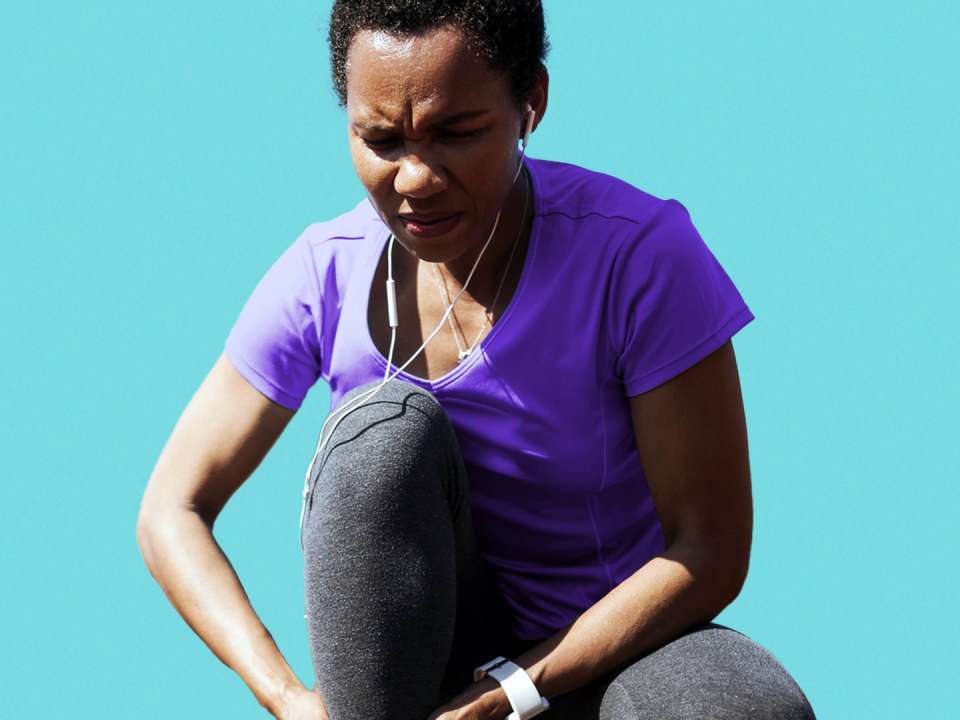6 Common Running Injuries (and What to Do About Them)

Whether you’re a marathon runner or an occasional jogger, it’s common to encounter a running injury at some point in your training journey. Dealing with pesky knee pain and not sure what the culprit could be? In rehab from a stress fracture or torn ligament? You’re on the same path as many other runners.
Learning about some of the most common running injuries can teach you how to address or prevent pain that can delay you from hitting your next PR.
Plantar fasciitis
Plantar fasciitis is a type of overuse injury that is very common among long-distance runners and heavier people.
The classic symptoms of plantar fasciitis are heel or arch pain that’s worse with the first few steps after rest or sleep and gets better after a few minutes of stretching or walking.
You might feel pain-free when running with plantar fasciitis once your heels and aches are stretched out, but this does not mean you aren’t damaging them; it simply means your endorphins are kicking in. Consider cross-training if you have this type of injury; I often recommend cycling, swimming, deep-water running and elliptical training for patients with plantar fasciitis.
IT band syndrome
If you’re feeling pain over the lateral (outside) knee but haven’t had a fall or other type of trauma, this pain is very commonly caused by iliotibial (IT) band syndrome.
The IT band is dense connective tissue that runs along the outside of the leg from the hip down to the knee. As it attaches to the tibia (the shin bone), it has to cross over a bony prominence. Sometimes, your IT band can get irritated at this crossing, which can worsen with repetitive bending and straightening of the knee.
Runners with IT band syndrome often complain of more pain when running downhill than uphill or on flat surfaces. You may also notice that your pain gets worse when your foot strikes the ground, or while going up or down stairs. Some runners may also feel or hear a pop as they bend their knee.
Running high mileage, using worn shoes, running on banked surfaces or always running in the same direction around a track can increase your risk of developing IT band syndrome.
Shin splints
As runners increase their mileage before a marathon or a race, overuse injuries like shin splints — pain over the tibia — become more commonplace. Another name for this injury is medial tibial stress syndrome.
In medial tibial stress syndrome, pain is generally described as a dull ache felt diffusely over the front of the lower leg. Putting gentle pressure on the tibia or surrounding muscles may feel painful. In the beginning, pain is only when running, but as it progresses, your pain can become more continuous and last for longer after the run ends. If left untreated, shin splints can progress to stress fractures.
Stress fractures
A stress fracture is a partial or complete fracture of bone that occurs when repeated stress on the bone exceeds the bone’s ability to repair itself.
With a stress fracture, you may notice bone pain that increases with weight bearing and repetitive use. Common locations of stress fractures in runners include the tibia, metatarsals (long bones of the feet), and the fibula (outside lower leg bone). Other bones of the feet, the femur (thigh bone), and the pelvis can also experience stress fractures.
Stress fractures don’t happen in isolation — there are typically several contributing factors. An increase in training frequency, duration or intensity; running on a different surface than usual (such as running on concrete when you typically run on a track); or an “energy imbalance” (for example, not eating enough calories to replace what is used while running regularly) can contribute to a stress fracture.
If you think you might have a stress fracture, you should definitely see your physician, who will do an exam and get X-rays or an MRI if necessary.
Runner’s knee
Runner’s knee most commonly causes pain behind the kneecap. You’ll notice the pain worsen in certain positions or activities that increase the pressure between your kneecap and femur.
It’s not fully understood what causes runner’s knee. Traditionally, weakness of the vastus medialis (the innermost quadriceps muscle) was thought to contribute to abnormal movement of the kneecap, resulting in pain. More recently, weakness of the hip muscles, such as the gluteus medius (hip abductor), has been recognized as a contributing factor.
You might notice that runner’s knee pain is worse after sitting for prolonged periods or while climbing or descending stairs. In addition to swelling and instability in your knee, you may notice pain during your run, a short while after running or even the day after a workout.
Hamstring injury
Hamstrings, or the major muscles in the back of your thigh, are also prone to injuries. In fact, hamstring injuries are one of the most well-known injuries to runners, especially to those who train for long-distance races. There are a few different types of hamstring injuries:
A posterior thigh injury is a general term that indicates that the injury is on the back of the thigh but isn’t always hamstring-specific.
A hamstring strain consists of tiny tears of the muscle that you need a microscope to see. They’re commonly caused by over-stretching.
Hamstring tendinopathy is an injury to the hamstring tendon, which attaches the muscle to the bone.
A hamstring tear is a macroscopic — or visible — tear of the muscle or tendon. The tears can be partial or complete.
A hamstring injury typically presents as sudden back thigh pain felt during exercise. You may hear a pop (especially in partial or complete tears) or feel warmth in the area. As a runner, your risk of a hamstring injury is higher when you’re moving faster.
These injuries can also happen when you’re stretching and the muscle is lengthened beyond its elastic capability. You might notice swelling, bruising or tenderness in the area.
How to prevent injuries
Prevention is the best treatment. While easier said than done, appropriate training and race-day planning are the keys to preventing injuries during a race. Many runners decide to pursue a marathon but allow only a short timeline to prepare.
The vast majority of overuse running injuries are directly related to training errors or running too much too soon. Your training should be gradual. Muscles, tendons, bones and the cardiovascular system all need time to adapt to the stresses of conditioning.
Start by calculating your total weekly mileage. Try starting with lower mileage and speed runs during the week and a single longer run on the weekend. Be careful not to increase your total weekly mileage by more than 10% per week. Remember: If you are new to running, successful training for a marathon may take 6 to 12 months or even longer. Abrupt increases in running distance, intensity or frequency may cause one of these common overuse injuries.
Ultimately, most of these injuries can be avoided by training properly and allowing your body to gradually adjust to the demands of higher levels of conditioning.
Don’t forget to have a proper warm-up: Similar to a slow progression in running distance, the body needs adequate time to warm up before heavy training or competition. A light, short-distance jog and gentle stretching will assist the body and muscles adequately and prepare them for more intense exercise.
The best warm-up routine varies from person to person, but you should feel comfortable with your routine — including your stretches, meals, shoes and clothing — before race day.
If you get injured
Unfortunately, not all injuries can be avoided. From blisters to leg cramps, you must be prepared to modify your running if unforeseen problems arise. Don’t push through significantly painful symptoms.
For most injuries, reducing your mileage, icing or using heat, resting, taking over-the-counter anti-inflammatories like ibuprofen, and stretching can help your body recover. For chronic or severe pain, it’s likely time to see your doctor to discuss other treatment options.
If you develop unexpected limitations during training or a race, slow your pace, walk, rest or stretch before attempting to continue.
If you develop major symptoms such as chest pain, difficulty breathing, lightheadedness or confusion, stop immediately and ask for help. And remember: Train appropriately, plan well, listen to your body and, most of all — safety first.
Mark Harrast, MD, is a sports medicine physician and medical director of the Sports Medicine Center at Husky Stadium and the UW Medicine Seattle Marathon. He specializes in diagnosing and treating sports-related injuries and illnesses in endurance athletes, runners and triathletes. He is also an accomplished competitive endurance athlete himself.

 Healthy ideas for your inbox
Healthy ideas for your inbox





